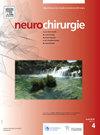Identifying early postoperative acute symptomatic seizure risk after burr hole drainage for chronic subdural hematoma
IF 1.4
4区 医学
Q4 CLINICAL NEUROLOGY
引用次数: 0
Abstract
Introduction
Acute symptomatic seizures (ASz) are a recognized postoperative complication following burr hole drainage for chronic subdural hematoma (CSDH); however, the risk factors remain poorly understood. This study aimed to identify clinical and radiological predictors of early postoperative seizures in CSDH patients, with the goal of enhancing risk stratification and informing individualized management approaches.
Methods
A retrospective analysis was conducted on 266 patients who underwent burr hole drainage for CSDH between 2022 and 2024. Data on demographics, comorbidities, hematoma characteristics, and postoperative complications, including seizures, were collected. Univariate and multivariate logistic regression analyses were performed to identify independent predictors of early postoperative ASz.
Results
ASz occurred in 10 patients (3.8%), with 4 experiencing isolated seizures and 6 having status epilepticus. Univariable analysis identified prior stroke (OR = 9.5, 95% CI [2.2–42.0], p = 0.011), diabetes mellitus (OR = 4.2, 95% CI [1.2–15.2], p = 0.032), and separated hematoma type (OR = 5.4, 95% CI [1.5–19.5], p = 0.015) as significant predictors of ASz. However, in multivariate analysis, prior stroke remained a significant independent predictor (OR = 6.4, 95% CI [1.3–30.9], p = 0.021), while diabetes mellitus and separated hematoma type were no longer statistically significant.
Conclusion
Prior stroke is the most consistent predictor of early postoperative seizures following burr hole drainage for CSDH. While diabetes mellitus and separated hematoma type showed initial associations, these did not persist in adjusted analysis.
慢性硬膜下血肿钻孔引流术后早期急性症状性发作风险的探讨
急性症状性癫痫(ASz)是慢性硬膜下血肿(CSDH)钻孔引流术后公认的并发症;然而,人们对风险因素的了解仍然很少。本研究旨在确定CSDH患者术后早期癫痫发作的临床和影像学预测因素,目的是加强风险分层,并为个性化的管理方法提供信息。方法回顾性分析2022 ~ 2024年266例CSDH钻孔引流患者的临床资料。收集了人口统计学、合并症、血肿特征和术后并发症(包括癫痫发作)的数据。进行单因素和多因素logistic回归分析,以确定术后早期ASz的独立预测因素。结果10例患者发生asz(3.8%),其中孤立性癫痫发作4例,癫痫持续状态6例。单变量分析发现既往卒中(OR = 9.5, 95% CI [2.2 ~ 42.0], p = 0.011)、糖尿病(OR = 4.2, 95% CI [1.2 ~ 15.2], p = 0.032)和分离血肿类型(OR = 5.4, 95% CI [1.5 ~ 19.5], p = 0.015)是ASz的显著预测因素。然而,在多因素分析中,既往卒中仍然是一个重要的独立预测因子(OR = 6.4, 95% CI [1.3-30.9], p = 0.021),而糖尿病和分离性血肿型不再具有统计学意义。结论既往卒中是CSDH钻孔引流术后早期癫痫发作最一致的预测因素。虽然糖尿病和分离血肿类型显示了最初的关联,但这些在调整分析中并未持续存在。
本文章由计算机程序翻译,如有差异,请以英文原文为准。
求助全文
约1分钟内获得全文
求助全文
来源期刊

Neurochirurgie
医学-临床神经学
CiteScore
2.70
自引率
6.20%
发文量
100
审稿时长
29 days
期刊介绍:
Neurochirurgie publishes articles on treatment, teaching and research, neurosurgery training and the professional aspects of our discipline, and also the history and progress of neurosurgery. It focuses on pathologies of the head, spine and central and peripheral nervous systems and their vascularization. All aspects of the specialty are dealt with: trauma, tumor, degenerative disease, infection, vascular pathology, and radiosurgery, and pediatrics. Transversal studies are also welcome: neuroanatomy, neurophysiology, neurology, neuropediatrics, psychiatry, neuropsychology, physical medicine and neurologic rehabilitation, neuro-anesthesia, neurologic intensive care, neuroradiology, functional exploration, neuropathology, neuro-ophthalmology, otoneurology, maxillofacial surgery, neuro-endocrinology and spine surgery. Technical and methodological aspects are also taken onboard: diagnostic and therapeutic techniques, methods for assessing results, epidemiology, surgical, interventional and radiological techniques, simulations and pathophysiological hypotheses, and educational tools. The editorial board may refuse submissions that fail to meet the journal''s aims and scope; such studies will not be peer-reviewed, and the editor in chief will promptly inform the corresponding author, so as not to delay submission to a more suitable journal.
With a view to attracting an international audience of both readers and writers, Neurochirurgie especially welcomes articles in English, and gives priority to original studies. Other kinds of article - reviews, case reports, technical notes and meta-analyses - are equally published.
Every year, a special edition is dedicated to the topic selected by the French Society of Neurosurgery for its annual report.
 求助内容:
求助内容: 应助结果提醒方式:
应助结果提醒方式:


